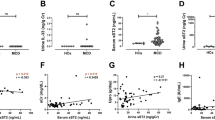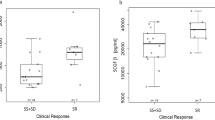Abstract
Elevated serum IgE levels have been related to glomerular diseases. We investigated the relationship between serum total and specific IgE levels and their modulating factors [interleukin-4 (IL-4) and sCD23] and the outcome of childhood nephrotic syndrome (NS) after steroid treatment. We found that children with NS had significantly higher serum IgE levels than age-matched allergic patients and normal controls. Patients with steroid-resistant nephrotic syndrome (SRNS) had higher serum IgE levels than patients with steroid-sensitive nephrotic syndrome (SSNS) both pre and post treatment. Elevated initial serum IgE levels appeared to be associated with poor outcome. Although one-half of nephrotic children had detectable specific IgE to common allergens (dust mites or milk), the presence of specific IgE was not correlated with disease outcome. Serum IL-4 levels were not different among normal controls and patients with SRNS or SSNS. However, serum sCD23 levels in NS patients were significantly higher than in normal controls both pre and post treatment. Serum sCD23, but not IL-4, levels were correlated with serum total IgE levels. Our results suggest that regulation of total IgE production correlates with the disease activity and outcome of NS, although the presence of common specific IgE may not be linked to the pathogenesis.



Similar content being viewed by others
References
Antignac C (2002) Genetic models: clues for understanding the pathogenesis of idiopathic nephrotic syndrome. J Clin Invest 109:447–449
Wardle EN (1996) Minimal change nephrosis and allergy. Nephron 74:422–423
Shu KH, Lian JD, Yang YF, Lu YS, Wang JY (1988) Serum IgE in primary glomerular diseases and its clinical significance. Nephron 49:24–28
Yap HK, Yip WC, Lee BW, Ho TF, Teo J, Aw SE, Tay JS (1983) The incidence of atopy in steroid-responsive nephrotic syndrome: clinical and immunological parameters. Ann Allergy 51:590–594
Hu JF, Liu YZ (1990) Elevated serum IgE levels in children with nephrotic syndrome, a steroid-resistant sign? Nephron 54:275
Laurent J, Rostoker G, Lheritier M, Wirquin E, Lagrue G (1989) Idiopathic nephrotic syndrome: the prognosis is not linked to the total serum IgE level. Nephron 52:283–284
Chayama K, Papst PJ, Garrington TP, Pratt JC, Ishizuka T, Webb S, Ganiatsas S, Zon LI, Sun W, Johnson GL, Gelfand EW (2001) Role of MEKK2-MEK5 in the regulation of TNF-α gene expression and MEKK2-MKK7 in the activation of c-Jun N-terminal kinase in mast cells. J Immunol 98:4599–4604
Sandberg DH, Bernstein CM, McIntosh RM, Carr R, Strauss J (1977) Severe steroid-responsive nephrosis associated with hypersensitivity. Lancet I:388–391
Lagrue G, Laurent J, Rostoker G (1989) Food allergy and idiopathic nephrotic syndrome. Kidney Int 27:S147–S151
Laurent J, Lagrue G, Belghiti D, Noirot C, Hirbec G (1984) Is house dust allergen a possible causal factor for relapses in lipoid nephrosis? Allergy 39:231–236
Lin CY, Lee BH, Lin CC, Chen WP (1990) A study of the relationship between childhood nephrotic syndrome and allergic diseases. Chest 97:1408–1411
Hagan P, Blumenthal UJ, Dunn D, Simpson AJ, Wilkins HA (1991) Human IgE, IgG4 and resistance to reinfection with Schistosoma haematobium. Nature 349:243–245
Finkelman FD, Katona IM, Urban JF, Holmes JJ, Ohara J, Tung AS, Sample JV, Paul WE (1988) IL-4 is required to generate and sustain in vivo IgE responses. J Immunol 141:2335–2341
Van Den Berg JG, Aten J, Anwar M, Chand A, Claessen N, Dukink L, Wijdenes J, Lakkis FG, Weening JJ (2000) Interleukin-4 and interleukin-13 act on glomerular visceral epithelial cells. J Am Soc Nephrol 11:413–422
Daniel V, Trautmann Y, Konrad M, Nayir A, Scharer K (1997) T-lymphocyte populations, cytokines and other growth factors in serum and urine of children with idiopathic nephrotic syndrome. Clin Nephrol 47:289–297
Corry DB, Kheradmand F (1999) Induction and regulation of the IgE response. Nature 402:B18–B23
Yano N, Endoh M, Takemura F, Naka R, Kashem A, Nomoto Y, Sakai H (1996) Involvement of interleukin-4 and soluble CD23 in hypersynthesis of immunoglobulins A and E in patients with IgA nephropathy. Nephron 72:44–51
Cho BS, Yoon SR, Jang JY, Pyun KH, Lee CE (1999) Up-regulation of IL-4 and CD23/FcεRII in minimal change nephrotic syndrome. Pediatr Nephol 13:199–204
Tain YL, Liu HC, Yang KD (2002) Implications of cell surface tumor necrosis factor receptors in nephrotic syndrome. Pediatr Nephrol 17:926–932
Lo SF, Chiang BL, Hsieh KH (1997) Analysis of total IgE and allergen-specific IgE antibody levels of allergic children in Taiwan. Chung-Hua Min Kuo Hsiao Erh Ko i Hsueh Hui Tsa Chih 38:375–380
Eigenmann PA, Sicherer SH, Borkowski TA, Cohen BA, Sampson HA (1998) Prevalence of IgE-mediated food allergy among children with atopic dermatitis. Pediatrics 101:E8
Sigurs N, Hattevig G, Kjellman B, Kjellman NI, Nilsson L, Bjorksten B (1994) Appearance of atopic disease in relation to serum IgE antibodies in children followed up from birth for 4 to 15 years. J Allergy Clin Immunol 94:757–763
Parry RG, Gillespie KM, Parnham A, Clark AG, Mathieson PW (1999) Interleukin-4 and interleukin-4 receptor polymorphisms in minimal change nephropathy. Clin Sci (Colch) 96:665–668
Kimata H, Fujimoto M, Furusho K (1995) Involvement of interleukin (IL)-13, but not IL-4, in spontaneous IgE and IgG4 production in nephrotic syndrome. Eur J Immunol 25:1497–1501
Tain YL, Chen TY, Yang KD (2003) Implications of serum TNF-β and IL-13 in the treatment response of childhood nephrotic syndrome. Cytokine 21:155–159
Author information
Authors and Affiliations
Corresponding author
Rights and permissions
About this article
Cite this article
Tain, YL., Chen, TY. & Yang, K.D. Implication of serum IgE in childhood nephrotic syndrome. Pediatr Nephrol 18, 1211–1215 (2003). https://doi.org/10.1007/s00467-003-1269-z
Received:
Revised:
Accepted:
Published:
Issue Date:
DOI: https://doi.org/10.1007/s00467-003-1269-z




